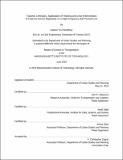| dc.contributor.advisor | John P. Attanucci, Saeid Saidi, and Jinhua Zhao. | en_US |
| dc.contributor.author | Wolofsky, Gabriel Tzvi. | en_US |
| dc.contributor.other | Massachusetts Institute of Technology. Department of Urban Studies and Planning. | en_US |
| dc.date.accessioned | 2020-02-28T20:50:05Z | |
| dc.date.available | 2020-02-28T20:50:05Z | |
| dc.date.copyright | 2019 | en_US |
| dc.date.issued | 2019 | en_US |
| dc.identifier.uri | https://hdl.handle.net/1721.1/123900 | |
| dc.description | This electronic version was submitted by the student author. The certified thesis is available in the Institute Archives and Special Collections. | en_US |
| dc.description | Thesis: S.M. in Transportation, Massachusetts Institute of Technology, Department of Urban Studies and Planning, 2019 | en_US |
| dc.description | Cataloged from student-submitted PDF version of thesis. | en_US |
| dc.description | Includes bibliographical references (pages 148-151). | en_US |
| dc.description.abstract | Transit service regularity is an important factor in achieving reliable high frequency operations. This thesis explores aspects of headway and dwell time regularity and their impact on service provision on the MBTA Red Line, with specific reference to the agency's objective of operating a future 3-minute trunk headway, and to issues of service irregularity faced today. Current operating practices are examined through analysis of historical train tracking and passenger fare card data. Headway regularity is explored in the areas of initial headway regularity, stability of line headways, and passenger impacts. A metric of effective utilization is proposed which quantifies the effect of headway irregularity on passenger capacity on an individual train basis. Dwell times are explored through a statistical approach without passenger regard, and through a regression approach with passenger regard, both applied to automated data. | en_US |
| dc.description.abstract | The proposed methods of dwell time investigation are applicable for other agencies with track occupancy and passenger fare card data for continuous monitoring and evaluation of dwell times. Following the identification of capacity consequences of service irregularity on the MBTA Red Line, three interventions were proposed and trialed in order to demonstrate operating practices consistent with the need to improve service regularity for future conditions. The first intervention trialed a drop-back crewing strategy at the trunk terminal, finding that the strategy is applicable to achieve necessary future reductions in operator layover time. Significant short-term benefits were also found, including reduction in terminal queuing delays, and improvements to schedule recovery following disruptions. | en_US |
| dc.description.abstract | The second intervention trialed a target headway-based holding strategy to mitigate initial headway irregularity caused by differences in allowable speeds for the two departure movements at the terminal. The intervention successfully improved mean journey times for the majority of passengers, and reduced extreme downstream bottleneck occupancy times, consistent with future capacity objectives. The third intervention trialed a variable target headway-based holding strategy following the branch merge to mitigate headway irregularity caused by stochastic branch travel times and simple schedule based coordination. The intervention successfully improved trunk headway regularity, contributing to reduced journey times and overcrowding at the peak load point. These interventions represent a starting point for a program of incremental service regularity improvements necessary to achieve future capacity objectives. | en_US |
| dc.description.statementofresponsibility | by Gabriel Tzvi Wolofsky. | en_US |
| dc.format.extent | 166 pages | en_US |
| dc.language.iso | eng | en_US |
| dc.publisher | Massachusetts Institute of Technology | en_US |
| dc.rights | MIT theses are protected by copyright. They may be viewed, downloaded, or printed from this source but further reproduction or distribution in any format is prohibited without written permission. | en_US |
| dc.rights.uri | http://dspace.mit.edu/handle/1721.1/7582 | en_US |
| dc.subject | Urban Studies and Planning. | en_US |
| dc.title | Towards 3-minutes : application of holding and crew interventions to improve service regularity on a high frequency rail transit line | en_US |
| dc.title.alternative | Towards three-minutes : application of holding and crew interventions to improve service regularity on a high frequency rail transit line | en_US |
| dc.title.alternative | Application of holding and crew interventions to improve service regularity on a high frequency rail transit line | en_US |
| dc.type | Thesis | en_US |
| dc.description.degree | S.M. in Transportation | en_US |
| dc.contributor.department | Massachusetts Institute of Technology. Department of Urban Studies and Planning | en_US |
| dc.identifier.oclc | 1139523830 | en_US |
| dc.description.collection | S.M.inTransportation Massachusetts Institute of Technology, Department of Urban Studies and Planning | en_US |
| dspace.imported | 2020-02-28T20:50:04Z | en_US |
| mit.thesis.degree | Master | en_US |
| mit.thesis.department | UrbStud | en_US |
